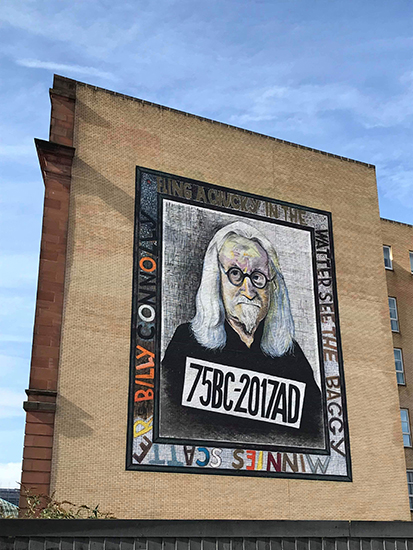13.4 From Leonard to Bissett
The Music Halls and the burgeoning Variety Theatres were at their peak in the early 20th century, and Variety survived the setback of Word War to influence early film and subsequently television entertainment. In addition, one form of Variety Theatre, Pantomime, was to emerge as the most enduring and successful form of live theatre in Scotland throughout the century.
However, the trajectory of Scots language was different, as a new literature-led Scots language renaissance began in the 1920s, gathering momentum in the 1930s. Richer Scots, with varying relationships to diverse forms of spoken Scots, was heard on small and then larger stages featuring in new, more realistic dramas.
As regards popular entertainment, the key factor was that many performers using Scots language moved between drama productions, Variety, Pantomime, and subsequently television. Versatile actors such as Duncan Macrae, Rikki Fulton, and Stanley Baxter, for example, survived and thrived by combining these different arenas and in the process they deployed a sophisticated understanding of spoken Scots in different social registers and contexts.
Some of this story belongs to theatre in its own right, but it is important to remember that Duncan Macrae could play the lead in Robert McLellan’s ‘Jamie the Saxt’ (1971) and perform ‘The Wee Cock Sparra’ at Hogmanay. Rikki Fulton formed a comic twosome with Jack Milroy as the hilarious Glasgwegians ‘Francie and Josie’, but he was also a master of stage Scots in Molière adaptations such as Robert Kemp’s ‘The Laird o’ Grippy’ (1987).
Stanley Baxter revelled in Scots linguistic diversity in his ‘Parliamo Glasgow’ broadcasts while also excelling as a pantomime dame and a straight actor.
Activity 9
In this activity you will be working with the text of Duncan Macrae’s ‘A Wee Cock Sparra Sat on a Tree [Tip: hold Ctrl and click a link to open it in a new tab. (Hide tip)] ’, which he adapted from an oral version which he heard recited in a student revue.
Read text and note down three examples of rhyme and repetition that give this piece its distinctive character.
A wee cock sparra sat on a tree,
A wee cock sparra sat on a tree
Chirpin awa as blithe as could be.
Alang came a boy wi'a bow and an arra,
Alang came a boy wi'a bow and an arra,
Alang came a boy wi'a bow and an arra
And he said: 'I'll get ye, ye wee cock sparra.'
The boy wi' the arra let fly at the sparra,
The boy wi' the arra let fly at the sparra,
The boy wi' the arra let fly at the sparra,
And he hit a man that was hurlin' a barra.
The man wi' the barra cam owre wi' the arra,
The man wi' the barra cam owre wi' the arra,
The man wi' the barra cam owre wi' the arra,
And said: 'Ye take me for a wee cock sparra?'
The man hit the boy, tho he wasne his farra,
The man hit the boy, tho he wasne his farra,
The man hit the boy, tho he wasne his farra
And the boy stood and glowered; he was hurt tae the marra.
And a' this time the wee cock sparra,
And a' this time the wee cock sparra,
And a' this time the wee cock sparra
Was chirpin awa on the shank o' the barra.
Answer
This is a model answer. Your answer might be different.
Three examples are:
- the signature line: A wee cock sparra – it is at the beginning of the line, it is thus more prominent
- the last line of one verse is also the first of the next, for example: Alang came a boy wi'a bow and an arra
- there is one rhyming feature that runs through the entire song, words with ‘rra’ in them: arra, sparra, barra, farra and marra – all words which are linked very strongly with the Glaswegian dialect of Scots and which function here as a linking element in all verses
With this piece we are back in the world of kitchen ceilidhs and speakeasies – note the cumulative repetitions allowing for multiple comic effects in performance. But Macrae carried this piece of exuberant nonsense off on huge variety stages and on television, because his skillful use of Scots resonated with contemporary spoken usage. Unlike some of the literary Scots in straight theatre, the spelling and pronunciation runs the words together to reflect in a heightened way of natural rhythms in urban speech.
It is interesting to see popular artists like Macrae anticipating some of the linguistic experiments that were carried forward by Tom Leonard and James Kelman in written literature. Their point was that contemporary Scots was not a parochial dialect to be looked down upon but a language in its own right, deserving of respect and expression, humorous and serious.
Tom Leonard articulates that point ironically in a poem ‘Parokial’ that employs his favoured monologue form – like the actors and comedians you came across before in this unit.
Activity 10
By the 1970s these streams of change were coming together in a confident and diverse use of spoken Scots across the arts and the broadcast media. The era of Billy Connolly, Dorothy Paul, Gregor Fisher, and Elaine C Smith had begun. Billy Connolly is especially significant in these developments because his career, like those of Will Fyffe and Harry Lauder, was to bridge any divide between his home following and international audiences.
Here is a video of one of Billy Connolly’s set-pieces, ‘The Crucifixion’. Listen carefully not just to the story but to the language in which it is expressed. The opening is low key and in standard English though spoken in a Scots accent.
“This is the story….and it’s about a girl in Glasgow who worked in a printing works and made a terrible misprint one day in the Bible. Because of her misprint people to this day think the Last Supper in The Saracen's Head Inn was in Galilee, but in actual fact it was in Gallowgate - near the cross. Near the cross!”
However, as soon as Connolly voices one of the characters in direct speech the language is contemporary urban Scots: “Gie us anither gless o wine……You telt me the Big Yin wis comin in…..Ah’m knackered..…Hope he gies us wan o thae stories….Big Yin, he’s steamin,” and so on. Even more striking however, is that Jesus also speaks in demotic Scots: “See you, Judas, you’re getting ontae ma tits……..Wan o yous’s goin shop me.” (our transcript of https://www.youtube.com/watch?v=8WgXPBDrd8s)
Then well into the piece, Billy Connolly starts narrating not in the third person (“he did…she did”) but in the first person as Jesus himself. In this way, the Scots voices become the defining reality markers of the whole narrative. This is agile storytelling because the unobtrusive shift of focus lends authority to the first person experience, in Scots, while also making that voice the expression of the external authority figure of Christianity - Jesus Christ.
In this way, Billy Connolly challenges the conventional norms of the community in which he was brought up, though in actuality the end effect may be more to humanise than denigrate the crucifixion story. The misprint in that canonical record, the Christian Bible, has concealed more than a question of locality - in the end it is about meaning, and of course the language which conveys meaning.
Very similar issues feature in a more recent Billy Connolly piece, in which he reacts to the Terrorist attack on Glasgow Airport in March 2011, which was thwarted by the actions of staff and public – most notably John Smeaton, the baggage handler. Connolly’s account preferences the speech and attitude of Smeaton in contrast to the metropolitan media, who are puzzled by the local response, and baffled by his answers to their questions. Clearly it is the local Glasgow perspective that has made the vital difference, and Connolly is proud to articulate that to his international audience. For this moment his own hometown is in the limelight, in a way that affirms its values and perspectives.
Another contemporary writer and performer who builds on these approaches is Alan Bissett. His work is interesting because it is rooted in his native Falkirk in the East of Scotland, showing with his work that Glasgow is part of a wider urban Scots context.
Here is the opening of The Moira Monologues which were produced in 2009, with (More) Moira Monologues following in 2017.
I dinnay gie a FUCK if yer man’s a bouncer!
Yer dug’ll no go near ma dug again. Or ken whit I’ll dae? Wantae ken whit I’ll dae tae it?
I’ll take its baws and I’ll squeeze them like that and see by the end?
It’ll look like its shat oot twa fuckn Pepparami.
And ken whit she says tae me, Babs?
Ken whit the cheeky cow actually says?
I’ll be phonin the Cooncil about you, Moira Bell!
I’m sick and tired ay your cerry-oan, Moira Bell!
Alan Bissett again brings together the popular comic and the literary stage through Scots, while he himself thrives as both a writer and a performer. Storytelling, Comedy and Popular Culture is a continuing story for Scotland, with the Scots language continuing to be centre stage. Certainly, Moira Bell’s ‘tung’ is no longer bitted in a scold’s bridle.
13.3. Music halls and the dominance of English

